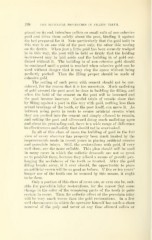Page 442 - My FlipBook
P. 442
198 THE TECHNICAL PROCEDURES IN FILLING TEETH.
plaecd on its end, introduce pellets or small rolls of uon-coliesive
gold and drive them solid]}* about the post, binding it against
the bed prepared for it. Note particularly that the gold built in
this way is on one side of the post only, the other side resting
on the dentin. When just a little gold has been securely wedged
in in this way, the post will be held so firmly that the holding
instrument may be laid aside and the building in of gold con-
tinued without it. The building in of non-cohesive gold should
be continued until a point is reached when cohesive gold can be
used without danger that it may clog the space without being
perfectly packed. Then the filling proper should be made of
cohesive gold.
The setting of such posts with cement should not be con-
sidered, for the reason that it is too uncertain. Much malleting
of gold around the post must be done in building the filling, and
often the hold of the cement on the post will be loosened and
the post become insecure. Careful trials of results show that
by filling against a post in this way with gold, nothing less than
actual breakage of the tooth, or the post itself, can move it. As
between using jjosts in roots to secure artificial crowns when
they are pushed into the cement and simply allowed to remain,
and setting the post and afterward doing much malleting upon
and about its protruding end, there is a wide range of difference
in effectiveness and safety that should not be overlooked.
In all of this class of cases the buikling of gold in the full
view of every observer has properly been much limited by the
improvements made in recent years in placing artificial crowns
and porcelain inlays. Still, the restorations with gold, if very
well done, are the more reliable. This plan should still be used
in many cases in which the esthetic demands are not so great
as to prohi])it them, because they afford a means of greatly pro-
longing the usefulness of the teeth so treated. After the gold
filling breaks away, if it ever should, the opportunity to place
an artificial crown will be as good as before. If five or ten years'
longer use of the tooth can be secured by this means, it ought
to be done.
Only a portion of this class of cases are, or ever can be, suit-
able for porcelain inlay restorations, for the reason that some
change in the color of the remaining parts of the tooth is quite
certain to occur. Then the esthetic effect of the porcelain inlay
will be very much worse than the gold restorations. In a few
well chosen cases in which the operator himself has made a clean
removal of the pulp and never at any time allowed saliva or


